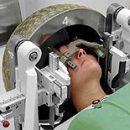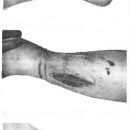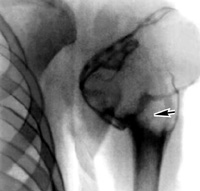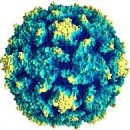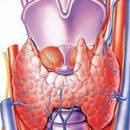What is Osteosarcoma? What types of exist? What are the risk factors for the development of osteosarcoma? How often is Osteosarcoma? Read in this article.
Content
Osteosarcoma
Bones contain several types of cells. Osteoblasts are responsible for the formation of the foundations of bones, namely, connective tissue and inorganic substances (minerals) that ensure bone strength.
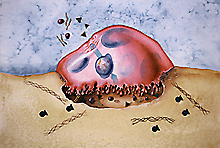 Osteoclasts help to regulate the level of inorganic substances in the blood, affecting the deposition and removal of these substances from the bones, which allows the bones to keep the necessary form. The bone marrow, which is available in some bones, contains fat, and most importantly, hematopoietic cells producing various blood cells.
Osteoclasts help to regulate the level of inorganic substances in the blood, affecting the deposition and removal of these substances from the bones, which allows the bones to keep the necessary form. The bone marrow, which is available in some bones, contains fat, and most importantly, hematopoietic cells producing various blood cells.
Distinguish flat and long tubular bones. Flat bones help protect against brain damage and chest cavity, abdomen and pelvis. For example, the bones of the skull and the chest belong to the flat bones, and the bones of the upper and lower extremities - to the long tubular bones.
Osteosarcoma is the most common bone tumor.
Like other malignant tumors, osteosarcoma can spread to nearby fabrics (muscles, tendons, fatty tissue), as well as through blood flow to other bones, lungs and other internal organs. This process is called metastasis.
Most often osteosarcoma occurs on the end parts of long tubular bones, especially in the field of knee joints. 80% osteosark in children and adolescents develops in these areas. The second frequency localization of osteosarcom is the top of the shoulder bone. However, osteosarcoma may occur in any bone, including pelvic bones and jaw.
Not all malignant bone tumors are osteosarcomas. Sarcoma Yinga is the second in the frequency of malignant tumor in children and adolescents. Other tumors are usually detected in adults and very rarely in children. These include Chondrosarcom, arising from cartilage, and malignant fibrous histiocyte.
Bone tumors include osteomes, chondromes, osteochondromes, eosinophilic granulomas, fibromes, xanthoma, giant tumors and lymphangiomas.
Subtypes osteosarcoma
There are several subtypes of osteosarcom with a different disease forecast.
Allocate osteosarcomas low, intermediate and high degree of malignancy.
Osteoblastic, chondroblastic, fibroblastic, mixed, small cell and telelangectatic options are found among the highland osteosarcomm.
The periosal version refers to the osteosarcomas of an intermediate degree of malignancy, in paraspreation and intramedullar options - to osteosarcomas of a low degree of malignancy.
The degree of malignancy osteosarcoma defines the disease forecast.
So, after complete removal of osteosarcoma low degree of malignancy, it is usually not required chemotherapy and the outcome of the disease is favorable.
With osteosarcomas, a high degree of malignant, it is necessary to use both operational intervention and chemotherapy. Exodus of the disease in patients with osteosarcomas of an intermediate degree of malignancy is inconsistent.
Most osteosarcom in children refers to high degree of malignancy tumors.
Meeting frequency osteosarcoma
Annually, on average, 2-3 cases of the disease per 1 million are registered in the world. Population.
In the US, about 900 new cases are diagnosed with osteosarcom in the year. Tumors are somewhat more common in male people compared to women's.
Teenagers and young people aged 10 to 23 years old are most often ill, although osteosarcoma may arise at any age.
Osteosarcoma risk factors
Age and Rost. The highest risk of osteosarcoma is noted during the rapid growth of the child, namely, in adolescence. Children who have a tumor, usually above their peers. This indicates the relationship between the rapid growth of bones and the risk of osteosarcoma.
Bones irradiation. People who have had radiation therapy about another tumor, there is an increased risk of post-osteo-osteosarcoma. Transferred irradiation at a young age, as well as high doses of radiation therapy (over 60 grade), increase the risk of osteosarcoma.
X-rays applied with a diagnostic purpose practically do not affect the risk of osteosarcoma.
Some diseases of bones. In children and adolescents with some bone diseases there is an increased risk of osteosarcoma when adult is reached.
Pedgety's disease is a benign, but prematubolic disease, in which one or more bones amazed. Usually the disease occurs over the age of 50 years. In 5-10% of cases, during the severe course of Pedge, bone sarcoma develops, and, as a rule, osteosarcomas.
Osteochondromes belong to benign bone and cartilage tumors. In the presence of multiple hereditary osteochondrr, the risk of development of osteosarcoma is increased. The greater the patient with osteochondr, the higher the risk of osteosarcoma.
Hereditary tumor syndromes. In children with some hereditary tumor syndromes there is an increased risk of osteosarcoma.
People with Lee Fraumen syndrome have increased risk of breast cancer, adrenal glands, brain tumors, osteosarcoma and other tumors.
Retinoblastoma refers to rare eye tumors in children. In 40% of cases of retinoblastoma are hereditary. In children with such tumors, the risk of osteosarcoma is raised. In the case of radiation therapy, the risk of developing the osteosarcoma bones of the skull increases.

